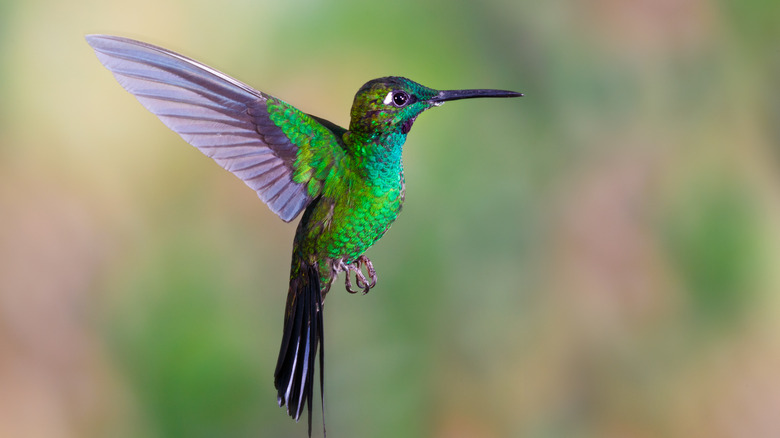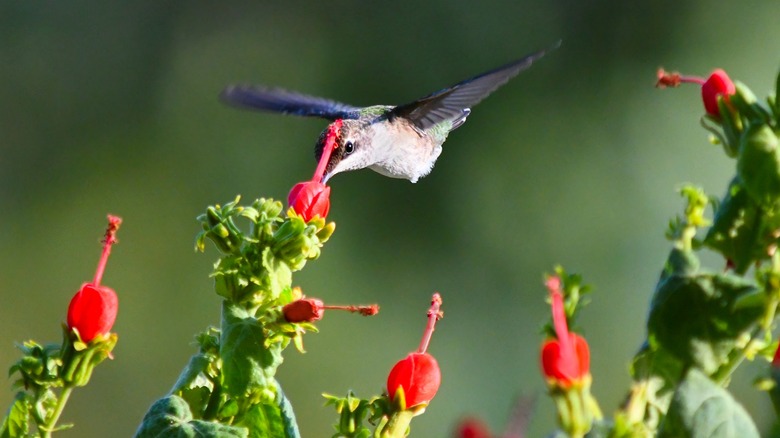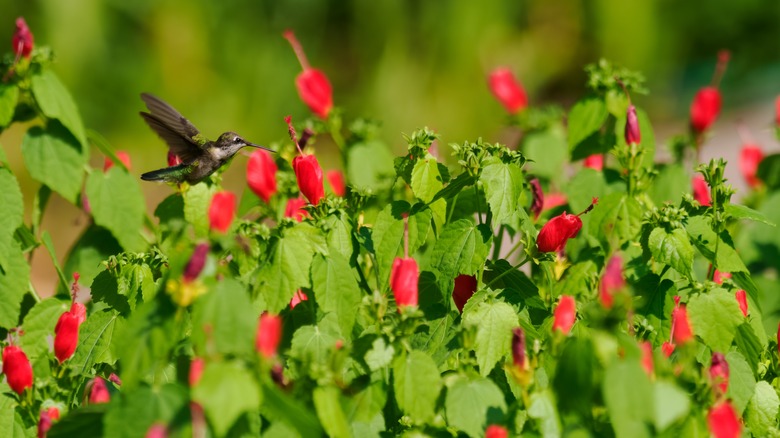The Vibrant Flowering Plant That Hummingbirds Will Love Through Autumn
The tiny, brightly-colored hummingbird is beloved by gardeners across the United States, so you'll find lots of tips and tricks to attract more hummingbirds to your garden. One of the best tips is to plant nectar-rich flowers that can nourish your tiny visitors while they're exploring your garden. Although hummingbirds sip nectar from many flowers, Turk's cap (Malvaviscus arboreus var. drummondii) is one of their favorites.
The showy, red flowering plant is native to the southeastern United States and parts of Mexico and hardy in USDA Hardiness zones 7 though 10. Typically growing up to about 4 feet tall and wide, the native shrub features bright flowers with long red stamens that are a favorite of hummingbirds looking for a rich source of nectar. It's also a flower you'll want in your garden to attract butterflies, as they also love feasting on the nectar-rich blooms. With vibrant blooms continuously on display from May through November, it'll keep hummingbirds and butterflies fed all through summer and fall, even after other flowers have begun to die back.
The long blooming season also makes it a gorgeous addition to any garden. It's also a hardy shrub that can tolerate drought, heat, and shade so gardeners can use it to add a pop of color to the trickiest spots in their garden. For best results, keep it watered to encourage lots of flowers and plant it in a couple of different areas around your yard so hummingbirds don't have to fight over one shrub.
Why you should plant Turk's cap for hummingbirds
Hummingbirds are always on the hunt for good sources of nectar, but their favorite flowers are bright red, orange, or yellow. They also prefer flowers with a long, tubular shape that they can dip their long beaks into to drink up the nectar. With its red, tube-like flowers and long stamens, Turk's cap checks both of those boxes. Its long blooming season also makes it an especially important nectar source for the small birds when few other options are available.
For gardeners, Turk's cap also makes a great landscaping plant. The deep green foliage can remain evergreen through winter in warmer climates, while the red hibiscus-like flowers add color well into fall. Even in colder climates where it dies back for the winter, it still puts on a stunning and long-lasting display during the growing season.
If your goal is to attract hummingbirds to your garden, be sure to plant multiple groupings of Turk's cap around your yard. Hummingbirds are territorial so having a few separate areas ensures multiple hummingbirds can browse your flowers without fighting each other. Most importantly, avoid using pesticides on Turk's cap or any other flowers. While hummingbirds enjoy nectar, they also need insects and spiders to round out their diet. Fortunately for gardeners, that bug diet includes aphids, mosquitoes, mites and other common pests. So, planting nectar-rich flowers like Turk's cap helps attract hummingbirds that can serve as natural and adorable pest control in your yard.
How to plant and care for Turk's cap
In the wild, Turk's cap is found growing along the edges of woodlands or streams. That means a site that has moist but well-drained soil and part shade light conditions would be the ideal spot for this plant. With that said, this southeastern U.S. and Mexican native is a drought-tolerant, shade-tolerant, and deer-resistant shrub that can adapt to just about any spot in your garden.
While it's a hardy plant that will thrive without much water, it puts on the best show when it's well-hydrated. So, water it in between rainy periods to make sure it's averaging about one inch of water per week. As confusing as it might sound, that means watering long enough to soak the top six inches of soil. Beyond that occasional watering, this shrub doesn't really require much maintenance to keep it alive. It does fine in poor soil and tolerates just about any conditions once established.
As low maintenance as it is, you might still want to give it some extra attention for to achieve the look you're going for. For example, you can use supports for the stems to encourage the plant to grow taller rather than sprawling outward. Alternatively, prune back stems here and there throughout the growing season to encourage it to stay short and compact. Meanwhile, to encourage more blooms and a tidier growth habit, prune back about half of last year's growth each spring.


